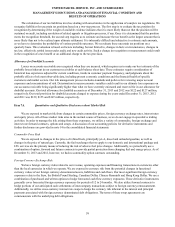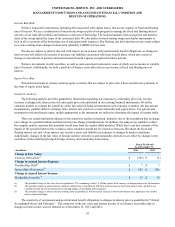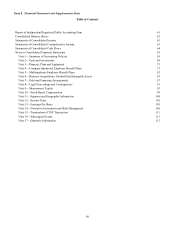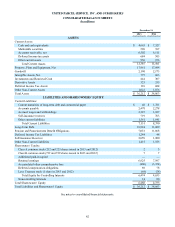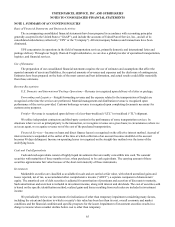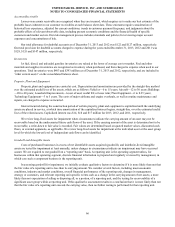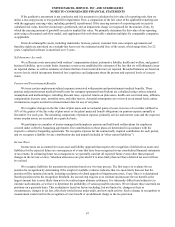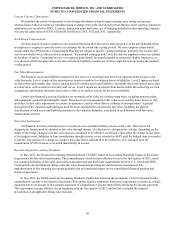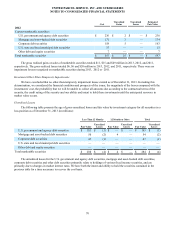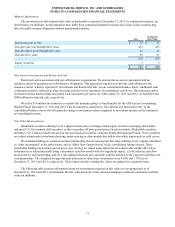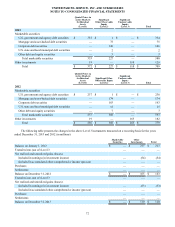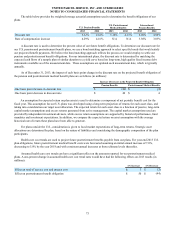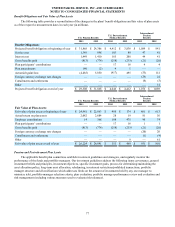UPS 2013 Annual Report Download - page 79
Download and view the complete annual report
Please find page 79 of the 2013 UPS annual report below. You can navigate through the pages in the report by either clicking on the pages listed below, or by using the keyword search tool below to find specific information within the annual report.UNITED PARCEL SERVICE, INC. AND SUBSIDIARIES
NOTES TO CONSOLIDATED FINANCIAL STATEMENTS
67
If the qualitative assessment is not conclusive and it is necessary to calculate the fair value of a reporting unit, then we
utilize a two-step process to test goodwill for impairment. First, a comparison of the fair value of the applicable reporting unit
with the aggregate carrying value, including goodwill, is performed. If the carrying amount of a reporting unit exceeds its
calculated fair value, then the second step is performed, and an impairment charge is recognized for the amount, if any, by
which the carrying amount of goodwill exceeds its implied fair value. We primarily determine the fair value of our reporting
units using a discounted cash flow model, and supplement this with observable valuation multiples for comparable companies,
as applicable.
Finite-lived intangible assets, including trademarks, licenses, patents, customer lists, non-compete agreements and
franchise rights are amortized on a straight-line basis over the estimated useful lives of the assets, which range from 2 to 22
years. Capitalized software is amortized over 5 years.
Self-Insurance Accruals
We self-insure costs associated with workers’ compensation claims, automotive liability, health and welfare, and general
business liabilities, up to certain limits. Insurance reserves are established for estimates of the loss that we will ultimately incur
on reported claims, as well as estimates of claims that have been incurred but not yet reported. Recorded balances are based on
reserve levels, which incorporate historical loss experience and judgments about the present and expected levels of cost per
claim.
Pension and Postretirement Benefits
We incur certain employment-related expenses associated with pension and postretirement medical benefits. These
pension and postretirement medical benefit costs for company-sponsored benefit plans are calculated using various actuarial
assumptions and methodologies, including discount rates, expected returns on plan assets, health care cost trend rates, inflation,
compensation increase rates, mortality rates, and other factors. Actuarial assumptions are reviewed on an annual basis, unless
circumstances require an interim remeasurement date for any of our plans.
We recognize changes in the fair value of plan assets and net actuarial gains or losses in excess of a corridor (defined as
10% of the greater of the fair value of plan assets or the plans' projected benefit obligations) in pension expense annually at
December 31st each year. The remaining components of pension expense, primarily service and interest costs and the expected
return on plan assets, are recorded on a quarterly basis.
We participate in a number of trustee-managed multiemployer pension and health and welfare plans for employees
covered under collective bargaining agreements. Our contributions to these plans are determined in accordance with the
respective collective bargaining agreements. We recognize expense for the contractually required contribution for each period,
and we recognize a liability for any contributions due and unpaid (included in “other current liabilities”).
Income Taxes
Income taxes are accounted for on an asset and liability approach that requires the recognition of deferred tax assets and
liabilities for the expected future tax consequences of events that have been recognized in our consolidated financial statements
or tax returns. In estimating future tax consequences, we generally consider all expected future events other than proposed
changes in the tax law or rates. Valuation allowances are provided if it is more likely than not that a deferred tax asset will not
be realized.
We recognize liabilities for uncertain tax positions based on a two-step process. The first step is to evaluate the tax
position for recognition by determining if the weight of available evidence indicates that it is more likely than not that the
position will be sustained on audit, including resolution of related appeals or litigation processes, if any. Once it is determined
that the position meets the recognition threshold, the second step requires us to estimate and measure the tax benefit as the
largest amount that is more likely than not to be realized upon ultimate settlement. It is inherently difficult and subjective to
estimate such amounts, as we have to determine the probability of various possible outcomes. We reevaluate these uncertain tax
positions on a quarterly basis. This evaluation is based on factors including, but not limited to, changes in facts or
circumstances, changes in tax law, effectively settled issues under audit, and new audit activity. Such a change in recognition or
measurement could result in the recognition of a tax benefit or an additional charge to the tax provision.



